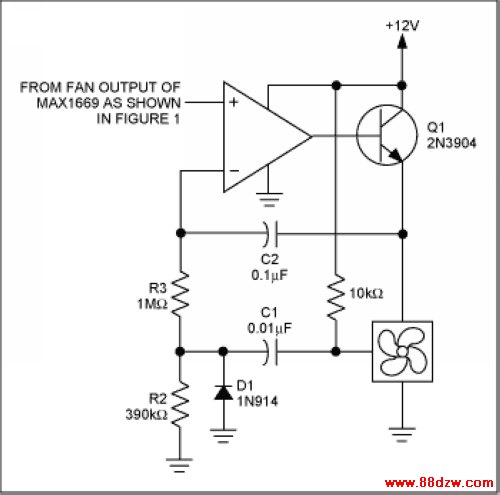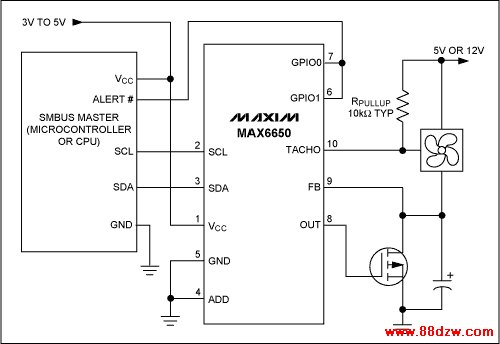Fan Control Advances: Consider
[09-13 17:03:04] 来源:http://www.88dzw.com 控制技术 阅读:8926次
文章摘要:The MAX1669, along with a tachometer feedback amplifier, offers a "clean" solution to this problem by regulating fan speed (Figure 3). This trades complexity along with the effort of designing the fan control amplifier. The feedback loop of the fan control amplifier contains both different
Fan Control Advances: Consider,标签:计算机控制技术,工厂电气控制技术,http://www.88dzw.comThe MAX1669, along with a tachometer feedback amplifier, offers a "clean" solution to this problem by regulating fan speed (Figure 3). This trades complexity along with the effort of designing the fan control amplifier. The feedback loop of the fan control amplifier contains both differentiation and integration, the time constants of which have to be found empirically for a given make and model of fan (once found, they can be fixed for production). This additional circuit adds cost in with its higher component count.

Figure 3. Using this fan control amplifier with the MAX1669 will provide full range linear regulation (as opposed to fan control) of fans equipped with tachometer outputs.
Regulating Fan Speed
Maxim's newest fan controllers, the MAX6650 and MAX6651, make fan speed regulation possible. The MAX6650/MAX6651 are closed-loop fan control ICs designed to accept feedback from the tachometer output of a fan. This makes programming fan speed straightforward without the user having to worry about startup or slow speed reliability issues. Although both the MAX6650/MAX6651 can drive multiple fans (with tach feedback from only one of those fans), the MAX6651 has a provision to monitor the tachometer signals of up to four fans.
Figure 4. The MAX6650 is a true fan speed regulator, by virtue of including a tachometer output fan in its feedback loop.
Figure 4 depicts a typical application for the MAX6650. The MAX6650 regulates fan speed based on a code programmed into its fan speed register, by forcing the fan tachometer period to be equal to the scaled register value. Because typical fans produce two tachometer pulses per revolution, the required fan speed register value is calculated as:

where:
KTACH = Value programmed into the fan speed register
tTACH = Period of the tachometer signal
KSCALE = Prescalar value (set in configuration register of the MAX6650/MAX6651 from 1 to 16 with a default of 4)
fCLK = MAX6650/MAX6651 clock frequency (254kHz typ)
Other Advantages of the MAX6650/MAX6651
The MAX6650/MAX6651 not only regulate fan speed, but also perform a wealth of other functions. There are watchdog functions that detect when the control loop is not regulating, when fan speeds are beyond programmed watchdog limits, and other general purpose digital functions. Since these subjects are beyond the scope of this article, refer to the MAX6650/MAX6651 data sheet for details on all other functions.
Tag:控制技术,计算机控制技术,工厂电气控制技术,控制技术
- 上一篇:改进后的电路图
《Fan Control Advances: Consider》相关文章
- › Rev Up Your Fan Speed Control
- › FANUC6系统的特点及功能,FANUC6系统的硬件
- › FANUC 7系统的硬件结构及软件结构
- › Simple Circuit Activates Fan W
- › HFAN-08.2.0: Thermoelectric Co
- › Fan Control Advances: Consider
- 在百度中搜索相关文章:Fan Control Advances: Consider
- 在谷歌中搜索相关文章:Fan Control Advances: Consider
- 在soso中搜索相关文章:Fan Control Advances: Consider
- 在搜狗中搜索相关文章:Fan Control Advances: Consider
分类导航
最新更新




 当前位置:
当前位置: